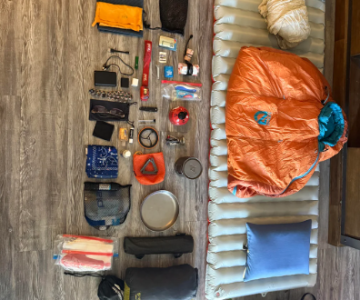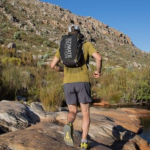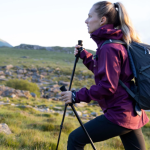Trail running has quickly become one of the most popular outdoor sports, attracting countless newcomers eager to explore the great outdoors while getting fit. If you’re considering giving trail running a try, you’re not alone. Thousands have already embraced this growing trend, but you might have a few questions. What’s the deal with the strange socks? And, are all trail runners just ultra-endurance masochists? In this article, I’ll break down why trail running is so popular, what it really involves, and how to get started.
Why Trail Run?
Some say we run because it taps into a primal instinct—our ancestors ran for survival, whether it was chasing prey or escaping predators. But modern humans run for a different reason: enjoyment. Trail running allows us to connect with nature and escape the chaos of daily life. It offers a refreshing change from urban environments, bringing peace and focus to the mind.
Trail running isn’t just good for your mental health—it also provides many physical benefits. Compared to road running, trails are gentler on the joints. The uneven terrain helps prevent repetitive strain injuries while giving you a full-body workout, targeting a broader range of muscles. Additionally, navigating the trails improves your balance and coordination, skills that can enhance your performance in other outdoor activities.
Types of Trail Running
As you get more involved, you may want to explore different types of trail running races. You’ll quickly find there are a few distinct disciplines in the world of trail running.
Cross Country Running
Originally a British sport, cross country involves running several laps around a short, marked course (usually between 1,750m and 2,000m per lap), totaling a distance of 8 to 12 kilometers. It’s both an individual and team sport, where participants score points for their teams, based on individual finishes. Cross country races are common during the autumn and winter months.
Fell Running
Fell running, also born in Britain, takes things up a notch. Unlike cross country, it involves running up and down steep mountain peaks, often in remote, rugged terrain. Many fell races lack marked trails, requiring strong navigational skills. These races can cover unpredictable landscapes, with no official course to follow.
Trail Running
Trail running encompasses a broad range of terrain, from coastal paths to forest trails, and even mountain routes. Unlike cross country or fell running, trail runs are known for their variety in terrain and distances. Whether you’re running a 5K or tackling a 100-mile mountain course, trail running caters to all types of runners. Events happen throughout the year, regardless of the weather, giving runners the opportunity to challenge themselves anytime.
Trail Running Skills
Unlike road running, trail running requires different skills due to the challenging and often remote nature of the terrain. Here’s what you need to know:
Picking the Right Line
When you first start trail running, it’s tempting to focus on your feet. However, it’s better to keep your eyes on the trail ahead. Scanning the path 4-5 feet in front of you allows you to plot your route over rocks and roots before your feet reach them. This skill helps maintain your speed and momentum while avoiding obstacles that could slow you down.
Running Technique
On trails, it’s best to adopt a shorter stride than you would on flat roads. Shorter strides help with balance on uneven surfaces and make it easier to navigate obstacles. This technique is also useful for steep descents, allowing you to maintain control and traction. For more on running technique, check out my article dedicated to trail running form.
Self-Sufficiency
As you venture into more remote and rugged areas, learning to be self-sufficient is essential. Whether you’re running locally or in the backcountry, it’s important to prepare for varying weather and terrain. Always pack essential items like water, food, extra layers, and a navigation tool. Being prepared will help you stay safe on longer, more challenging runs.
Navigation Skills
While race routes are often marked, self-guided runners need to be able to navigate. GPS devices and apps like Gaia or Strava can be helpful, but these are only effective when fully charged. A well-prepared runner should also know how to use a compass and map, especially in case technology fails.
Trail Running Gear
When it comes to gear, trail running requires a bit more than your typical road running kit. Here’s a quick breakdown of some of the essentials:
Trail Running Shoes
Trail running shoes are designed to handle rougher terrain. They typically have deeper lugs to provide better traction on mud, gravel, and loose soil. These shoes are also built with more durability and protection against rocks, roots, and other obstacles, making them ideal for uneven ground. Expect to see more vibrant colors in trail shoes compared to road runners, which helps with visibility in outdoor environments.
Hydration System
Staying hydrated is crucial in trail running, especially for longer distances. While short runs may only require a handheld bottle or waistpack, longer runs will need more extensive hydration systems. A hydration vest or pack is ideal for carrying larger amounts of water, as they provide easy access while running and offer space for other essentials like food, a first aid kit, and navigation tools.
Clothing
Running apparel is key for comfort on the trails. You’ll want moisture-wicking fabrics like merino wool or synthetic materials that dry quickly and keep you comfortable. Trail running shirts and jackets often come with ventilation features, such as zippered necks or underarm vents, to prevent overheating. Make sure your clothing allows for full mobility and has minimal seams to reduce the risk of chafing. Many runners also swear by compression socks for improved circulation and support.
How to Get Started
Join a Group
Starting with a group can make trail running more enjoyable and safer. You’ll benefit from the experience and local knowledge of others, and you’ll have the opportunity to run socially. If you’re looking for advice on training and racing, experienced runners are often happy to share their tips.
Run Solo
If you prefer running alone, it’s essential to familiarize yourself with the terrain first. Study maps of the area, research potential risks (such as weather or terrain challenges), and let someone know your plans. Make sure to stick to popular, well-trafficked trails, especially when you’re just starting out.
Where to Trail Run
Finding Local Trails
You don’t have to travel far to find great trails. Even in urban areas, you’ll likely be close to parks or green spaces with running trails. If you need help locating trails, tools like Strava, Trail Run Project, or a good trail guidebook can help. Joining a trail running club is another excellent way to discover new routes and meet like-minded people.
The Adventure of Trail Running
At some point, many trail runners dream of tackling more distant, remote trails. Whether it’s an iconic endurance event or a solo trip to uncharted wilderness, the thrill of running in places like the Andes, Rockies, or Alps is irresistible. There’s a whole world of adventure out there waiting for you.
The Trail Running Culture
Unlike the performance-driven culture of road racing, trail running has a more relaxed and fun vibe. While road runners may obsess over their pace and stats, trail runners appreciate the journey, enjoying the beautiful scenery and camaraderie with fellow participants. Trail running fosters a sense of community, with runners often supporting each other through shared challenges. Whether you’re crossing the finish line or taking a casual run, the connection with others is one of the sport’s greatest rewards.
Ready to Run?
The best way to get into trail running is to get out there and run. Whether you join a group or set out on your own, you’ll quickly find that the trails offer more than just a good workout—they provide an opportunity to experience nature in a way that’s both exciting and rewarding. If you need more tips on training, gear, or technique, be sure to check out more articles on trail running here on the blog.





